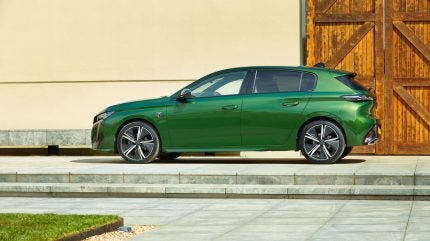
Look at registrations data in any of the main vehicle classes and there is often a small group of big sellers, followed by one other sometimes overlooked aspirant. This is the case in the European C segment where, as we know, Volkswagen leads, trailed by, fittingly, a model from the region’s number two brand Toyota, and then an Audi.
What comes next after the Golf, a car which remains well ahead of the nonetheless impressively popular Corolla and A3? A-Class or Focus? Neither. Instead it’s a Peugeot, some 80,000 examples of which have been retailed so far in 2024 and by year-end, potentially close to 100,000.
Better to drive than a Golf?
If the world was a fair place, the crisp handling and distinctive appearance of the 308 would see it outselling even the legendary VW, class champion in Europe for many a decade. Alas, even after multiple generations of 307 and 308-badged models, Peugeot remains a follower rather than the leading lion it deserves to be.
There aren’t many family hatchbacks or estates which can compete with the Focus. The 308 absolutely is one though. Peugeot has some of the best chassis tuning people in the business as the handling of its C segment models (308, 3008 and even the far heavier E-308 and E-3008) shows. Throw in the marque’s famous and well-earned reputation for comfort and this makes for a highly desirable package. If you love how the 308 has been styled, then suddenly the Golf as class default choice seems questionable.
Strong looks for each bodystyle
How well do you really know your competitors?
Access the most comprehensive Company Profiles on the market, powered by GlobalData. Save hours of research. Gain competitive edge.

Thank you!
Your download email will arrive shortly
Not ready to buy yet? Download a free sample
We are confident about the unique quality of our Company Profiles. However, we want you to make the most beneficial decision for your business, so we offer a free sample that you can download by submitting the below form
By GlobalDataThe Corolla is probably the best looking model in its segment with the award for the most unique being the 308 and its E-308 electric variant. I would say that about both the five-door and the SW. Can it really be as long ago as 2021 (2022 in the UK) that this then-radical new take on how Peugeots look appeared?
As with the most enlightened brands, this one keeps gaining fresh generations of its best sellers after not-too-lengthy life cycles. And no surprises that the 208, 2008, 3008 and 308 therefore keep selling so well. In fact the last of these is now coming up for its mid-life facelift but that probably won’t debut until 2025.
Peugeot as a brand is doing very well considering how cut-throat competition is, how many EVs it has in what is a big selection of models, and the number of brands it has to compete with. UK market sales are good, up nine per cent in October and its ranking is eighth. Which is the same position it now enjoys Europe-wide. Germany is an even better story, registrations soaring by 40 per cent (also year-on-year) last month.
Mild hybrid but badged Hybrid
One of those new variants which has been added to the 308 range in 2024 is the Hybrid. Technically an MHEV, it can justify the tailgate badge as the powertrain is able to move the car short distances on electrical energy alone.
The 100 kW (136 PS) combined output of the 1.2-litre turbocharged engine and motor is the same as in many other Stellantis models. As in the 408 Hybrid which I tried not too long ago, the transmission is a six-speed dual clutch automatic (‘eDSC6’) and drive is to the front axle. The battery’s capacity is 0.9 kWh and the motor on its own puts out 21 kW and 55 Nm.
Peugeot reckons the average CO2 saving compared to the non-hybrid version of the 1,199 cc three-cylinder engine is a worthwhile 19 g/km. This also means a reduced rate of VED and lower BIK tax for company car drivers.
Three model grades
The Hybrid 136 is available for Active, Allure and GT trim levels, with the most expensive of those three being the one I tried. It certainly looks the part and that applies to the interior too with many sports-premium touches. That includes soft lighting in a variety of understated colours and luxurious upholstery. If only that extended to squishier plastics but the hard stuff is mostly down low where you don’t notice it too much.
The other liquid fuel propulsion system choices are a 130 PS 1.2 turbo, a 1.5-litre diesel with the same output and 180 PS or 225 PS 1.6-litre plug-in hybrids. Each is two-wheel drive and linked to an eight-speed automatic transmission. The EV, meanwhile, is called 156 (power in PS) and has a 54 kWh battery.
Customisable toggles
Some people claim they don’t like the Peugeot i-Cockpit interior concept but I cannot really understand why. It works even better than it looks and there’s quite a visual feast to see what with the low and small steering wheel plus a very intelligently designed touchscreen.
Even better than the perfectly logical layout of the 10-inch screen, actual hard pieces of plastic exist for multiple functions. Not only do these ‘keys’ feel great, they make driving that much safer. And from Allure trim upwards, there are customisable ‘i-Toggles’ controls. These allow for personalised shortcuts.
Summary
Taking into account the vast space in both cabin and boot, the keen dynamics, something-for-everyone powertrain choices and keen pricing, the 308 ought to dominate its segment. It’s more than good enough to do so.
Pricing for the 308 starts at GBP29,440 OTR (Active 1.2 PureTech 130 EAT8) and GBP30,240 for the Hybrid 136 e-DSC6 in the same trim level. The as-tested GT costs £34,445.



